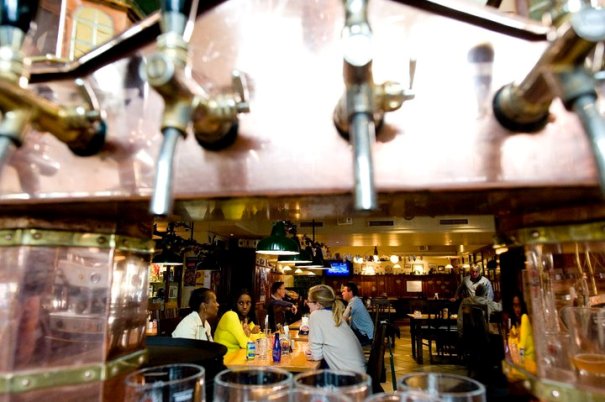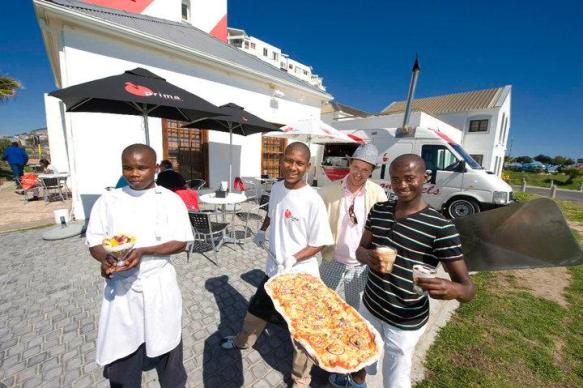This October marks 20 years since the East and West Germanys were united. German politicians prefer to call it die Wende (‘the turnaround’) since the word ‘reunification’ is politically sensitive and problematic on historical grounds.
The celebration coincides with the 200th anniversary of that great swilling of beer – the Oktoberfest – when Bavarians (according to the City of Munich’s Department of Economic Development) quaff a mind-numbing 7 million litres of the brew. The beer is quality stuff, unadulterated thanks to the Reinheitsgebot (‘purity law’) of 1516. The only ingredients allowed are water, hops and barley-malt.
My first lapse in a Munich beer hall was before the Berlin wall broke. Hofbräuhaus was celebrating its 400th year. It was everything I’d expected: a cavernous hall with an oompah band and six thousand people shovelling outsized pretzels and sausages. Some had brought their own ornate tankards. Strangers locked arms and sang lustily, rocking on benches. Blonde, buxom waitresses with pigtails and dressed in dirndls, bustled about shouting vorsicht (“caution!”), carrying up to eight giant glass beer mugs at a time. I saw one guffaw good-naturedly when a drunken male patron pinched her plump hams. She didn’t spill a drop.
Earlier this year, I returned to Munich’s bacchanalian beer halls. My favourite (for sentimental reasons really) is the Augustiner, originally a monastery. Nothing much had changed, except now more than half the clientele are tourists, while Alpine barmaids are in short supply. Instead, I was served in perfect German by a woman of East Asian and by a man of Indian descent. To get a litre of beer (6.90€) you just ask for “Ein Maß bitte”.
The Oktoberfest, which started life as a horserace, is a very Bavarian event, but it has spread to other parts of the world. Expats and their progeny tend to put regional prejudice aside outside the fatherland.
The double-storey Paulaner Brauhaus in the V&A Waterfront is more tourist magnet than trap. They have a loyal local following and offer party kegs of beer (up to 30 litres in size) by prior arrangement. Two impressive, giant copper beer kettles stand at the rear of the bar counter; you can see steam escaping every now and again. A malt mill is visible behind glass. The beer is made on site under brewmaster Wolfgang Ködel. He is brewing up a special batch of 6000 litres of dark amber-coloured beer for Oktoberfest, which runs here in Africa until the end of the month. The oompah Songscape Bierfest Band and KeeZee, a German-born female singer, will entertain the crowds. The 450-seater outdoor beer garden is partially covered by a Bedouin tent.
The menu is Bavarian and I can highly recommend all their signature dishes. The crusty, dark crumbed pork schnitzel (R95) is moist and scrumptious inside. It comes with chips, but try ordering it with their traditional-style potato salad (kartoffelsalat) prepared with vinegar, rather than mayonnaise. If you’re very hungry, then you can’t go wrong ordering the crispy, enormous roast pork knuckle (R105). Naturally, they offer a range of sausages (Germans apparently eat 30kg of sausage per person per annum). The nine grilled ‘Nürnberg-style’ sausages (R95) arrive in a pan with mash, mustard and a flavourful sauerkraut fermented to just the right tartness, rich in apple and not too sour. A little-known fact is that Captain James Cook considered sauerkraut one of the secrets to his success on his long voyages.
Also celebrating is Dinkel, the charming German bakery conveniently close to Cape Town’s German school. Under the new ownership of Brigitte Pack and her husband Gerhard, they officially launch with Oktoberfest specials. The bakery takes its name from the German word for spelt. Spelt, also called German wheat, has been grown at least since 4000BC. It is noted for its high protein and moderate gluten content. Dinkel make a 100% dinkel bread. It is light, nutty and tasty, and amorous of olive oil. They use only stone-ground flours and organic produce. Among the many baked attractions are sauerkraut bread, Blackforest rye and salty pretzels.
In numerous ways, I feel the Germans have it right. In the beer halls, you get excellent fare and lots of it at a sensible price. There’s something very democratic about their delicious, wholesome and large food, and about beer in general.
Paulaner Bräuhaus, Clock Tower Precinct, V & A Waterfront, Cape Town. Tel: 021 418 9999.
Dinkel, 91 Kloofnek Road, Tamboerskloof, Cape Town. Tel: 021 424 3217.
Augustiner Großgaststätte, Neuhausenerstr 27, Munich, Germany. Tel: 089 231 83257.
Hofbrauhaus, Am Platzl 9, Munich, Germany. Tel: 089 290 1360.
This article appeared in the Mail & Guardian October 15, 2010.


